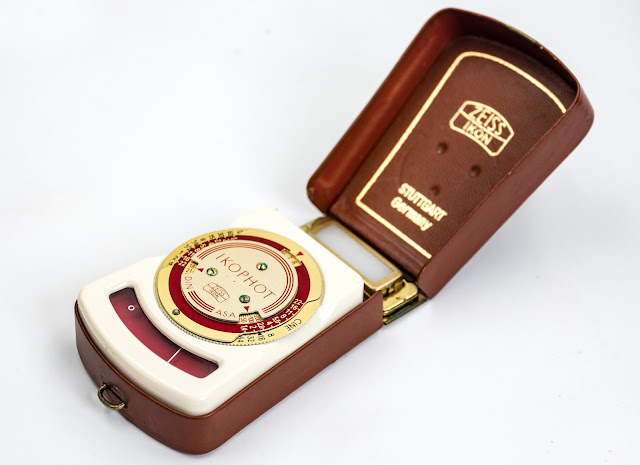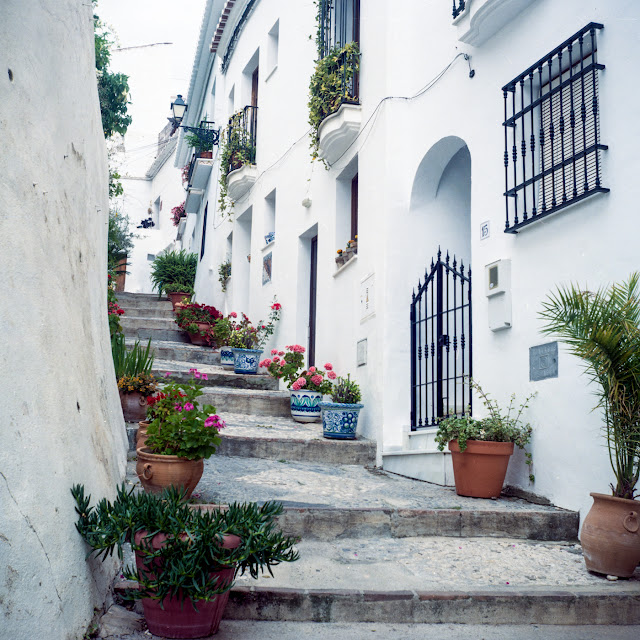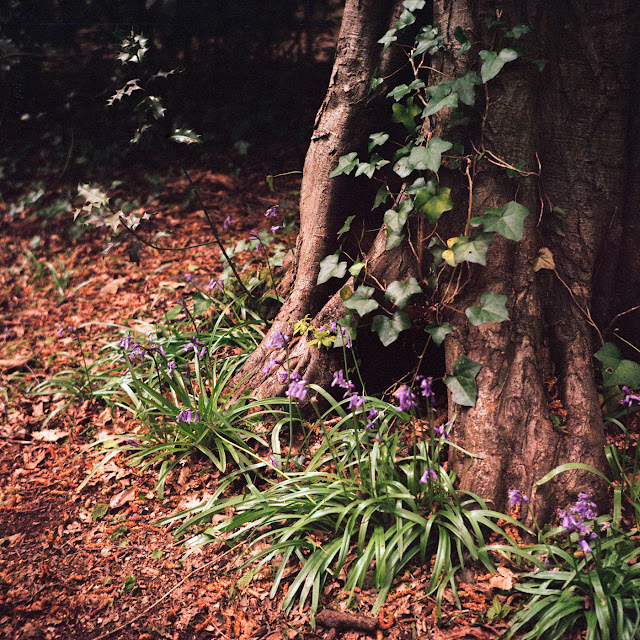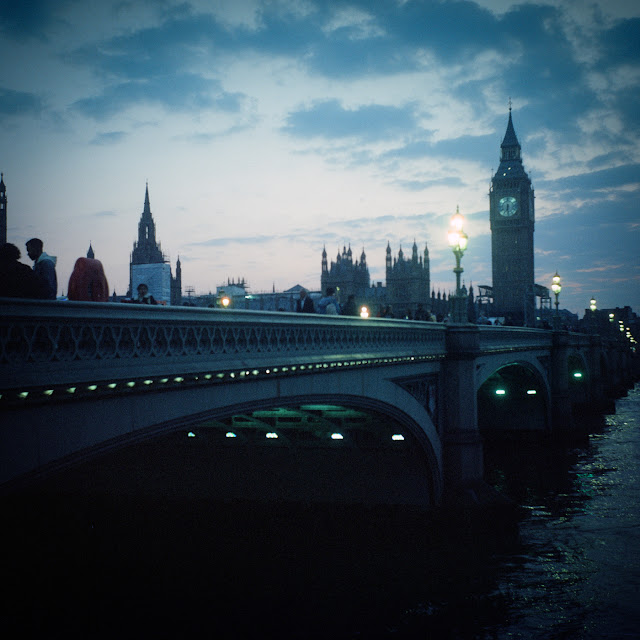After World War Two production resumed with an upgraded range of cameras including in 1949 the 518/16 seen in the picture above which, despite the name, took 12 pictures not 16. The reason for the reduced number of shots was because the negatives were larger again, and this time square. More modern in appearance (for the time) it was still a folding camera but beginning to resemble the modern cameras which followed in the 50's and 60's which we might call 'classic' in their design. The controls remained simple and the options simpler. There was no light meter so you needed a working knowledge of photography and basic settings for different lighting conditions, such as the well known 'Sunny 16' rule (The sunny 16 rule is a method for estimating correct daylight exposures without a light meter. It states that on a clear, sunny day, when you are using an aperture of f/16, your shutter speed should be the inverse of your ISO value. For example, at ISO 100, use a shutter speed of 1/100. This rule can help you achieve correct exposure of difficult subject.).
Likewise a red dot on the focusing ring, in a a kind of forerunner to autofocus, meant that if you kept to that setting, with your aperture on f11, you could be sure of having everything in focus from 11 feet (roughly 3.5 meters) to infinity. If this sounds like a faff, it is until you learn it then its automatic. Its a good way of learning why photography works, the physics of it if you like, and if you have that it opens the door to getting results from a massive landscape of affordable vintage cameras. Not everyone collects
These cameras are sometimes called Signal Nettars because once you've taken your pic, a red flag appears in the viewfinder to warn you not to double expose the frame and to wind on before firing again. Pretty ingenious.
Modern film is both much faster and more forgiving than the film of the era. For example a standard Kodacolor film in the 1950's would typically be at ISO (or EI) 32. Nowadays 100 is considered slow and 400 is considered standard, though perhaps to some surprise to older shooters who shot in film in the 80's and 90's when 100 was considered standard and 400 was a low light film, so generally speaking speeds have staircased upward. At a time when ISO/EI 800 is commonly available its understandable that views have changed. However what hasn't changed is the film speed dial on the lens barrel which only goes as far as 200 so don't bother putting anything higher than that in unless you fancy some experiments in overexposure.
Another thing that hasn't changed is that reversal, or slide, film. still requires an accurate exposure so if you're going to run some Provia, Velvia or Ektachrome through this camera, you'll be needing a lightmeter of some kind at hand. You can get plenty of apps for your smartphone though I like to use a vintage Zeiss lightmeter which still gives good results 70 years later and naturally it has that gorgeous aesthetic of the period.
So you have your lightmeter or have put committed Sunny 16 to memory. You can judge the distance on the focus ring, or maybe you've invested in a little rangefinder attachment for the accessory shoe (and there are plenty on eBay). What's this camera like in operation? Like all these early cameras its slows you down and makes you appreciate how much thought went into taking a photo. And it was just as well. Photography was an expensive hobby in the early 50's. Our Zeiss Ikon Nettar cost nearly £17 at a time when the average weekly wage was just £6, and this was no Leica - that would have cost a whopping £150. Film and processing was equally pricey, coming out at about £1 for colour (or a fifth of the average weekly salary) or 50p for black and white. That's based on 12 pictures from 120 film. If you were lucky enough to be able to afford a 35mm camera and were shooting 36 shots it was considerably more expensive. So, if you were pressing that shutter it had to matter. No wonder that that the vast majority of pictures were loved ones, family events and the odd family holiday. In a country where wartime rationing was still a thing until 1954, these pleasures mattered so they were lovingly recorded, and photography as art remained the preserve of the well off.
All of which is a pity, because this camera takes beautiful pictures, At larger apertures its a little prone to vignetting though that's not unattractive and lends photos a retro feel, but the results are better than you think they will be. For what is essentially an entry level camera the lens quality is exquisite, as you would expect from anything with the name Zeiss associated with it. The negative is large and lends itself to simply phenomenal quality prints. The first picture below, taken in a quiet Andalusian hilltop village called Frigiliana, half an hour away from a busy resort on Spain's Costa del Sol, really shows the possibilities when you push this camera past family snaps. It's sharp front to back. The colours are crisp and contrasty and any lens distortion is hidden by the jumbled together nature of the buildings.
In dimmer light I needed to find something to lean against because the shutter speed really dropped and I needed to steady myself without a tripod to hand. In this picture below, taken at Highgate Woods in London, I was blown away once again by the quality. At full resolution the picture wouldn't look out of place in a magazine. It has the necessary sharpness and is almost grain-free due to the large negative size. At the same time the edges have a softness which you only ever see in older lenses, and this is not unpleasant at all. It adds to this particular scene, giving the picture a vintage feel.
Next I tried some dusk photography using Cinestill 800T film and this photo of Westminster Bridge and the Houses of Parliament showed a pleasing result. Less sharp and the image is rather cool for using tungsten balanced film in daylight (just about) conditions, but its not unpleasant and shows once again that if you understand the basics of the camera's operations you can push it through the edge of its useable environment and get some lovely results, even compensating for the camera only going up to ISO 200. I've got the same film in 35mm and now I'm waiting to see if I can get similar results when dusk doesn't fall at such an insanely late hour.
Lastly, proving that even pernickety slide film can give a good result on a completely manual camera, for this I took a lot of care, using a lightmeter and making sure I had my camera settings dialled in correctly, which isn't as easy as it sounds because they don't always match up with modern readings. Ektachrome is one of those films which, in 120 format at least, seems not to have been affected by the shortages of recent years. Its an incredibly rich film with beautiful saturation and without the harshness of, say Ektar negative film which works really well for many things, but can be a bit of a blunt instrument. Ektachrome is glossier and smoother in its finish and perfect for those sunny days when you just want to remember what its like to be in a t--shirt without shivering, and wearing those cool Ray-bans that never go out of style. Just look how the blue sky pops and the red boat glows without ever really burning into your eyes. Absolutely beautiful film.
The Nettar is one of several vintage cameras in my collection which didn't cost me much, or were donations. Its also one of my favourites. I love the larger film format for the potential it brings, and the quality of the Novar Anastigmat lens is exemplary/ The relative affordability of film photography these days compared to its early 50's heyday has unlocked its power to deliver a wider range of subjects than before with more choice of film, showing what its really capable of. A great camera to introduce people to medium format with.








Comments
Post a Comment